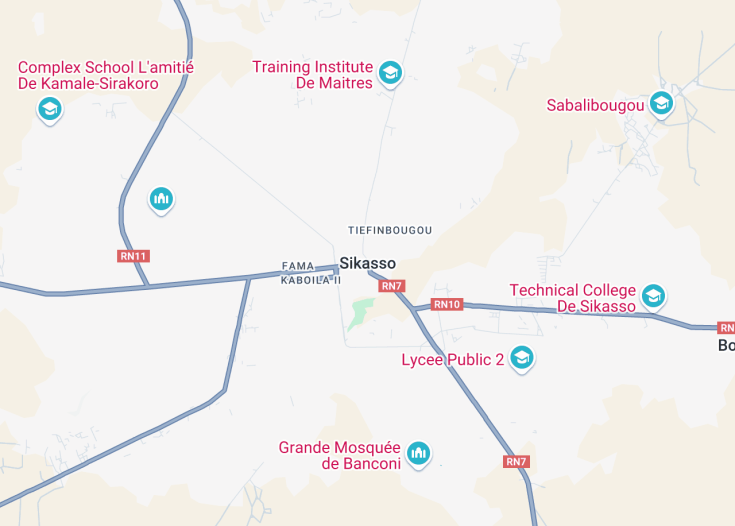Sikasso, the second-largest city in Mali, is a remarkable destination steeped in rich cultural heritage and natural beauty. Situated in the southern region, it serves as an agricultural hub, surrounded by fertile lands that produce a plethora of crops. Known for its historical significance, Sikasso features pre-colonial architecture, local markets brimming with vibrant crafts and textiles, and the famous Tarikela Hill. The city also hosts the annual Triangle du Balafon festival, celebrating traditional music and dance, making it a vibrant spot for cultural enthusiasts and history buffs alike.
Before traveling to Sikasso, ensure to plan your visit during the dry season from November to February for the best weather conditions and cultural experiences.
Check out the Sikasso Regional Museum to gain insightful knowledge about the local history, culture, and arts before exploring the city’s historic sites.
Sikasso: The Heart of Mali’s Cultural Richness
| Country | Mali |
| Time in Sikasso | GMT+0 |
| Language spoken | Bambara |
| Population | 225,753 (source: Mali Ministry of Urban Planning) |
| Currency | West African CFA franc (XOF) |
| Airports |
|
Sikasso is the second-largest city in Mali, served as a vital cultural and economic center. Nestled near the Ivory Coast and Burkina Faso borders, it boasts a rich history and vibrant cultural tapestry that traces back to the pre-colonial era. Known as a fortress city, Sikasso was once a bastion against the aggressive expansion of Samory Touré’s Wassoulou Empire in the late 19th century. Today, Sikasso remains crucial for its agricultural contributions to Mali’s economy, particularly in cotton production, which is among the highest in West Africa.
The city’s heritage is encapsulated in various historical and cultural sites, such as the Mamelon center of resistance and the Tomb of Tiekoro Bagayoko. Moreover, Sikasso’s marketplaces brim with life, offering colorful arrays of fruits, primarily mangoes, which are celebrated with an annual festival. The city’s commitment to cultural preservation is evident in its celebrations and public engagements, which include music, dance, and traditional Malian crafts.
Sikasso’s climate is tropical, characterized by a rainy season from May to October and a dry season from November to April. This climate supports a biodiverse environment, making it a region abundant in both flora and fauna, thereby adding to its charm as a destination for both tourists and scholars.
Among the critical contemporary issues faced by Sikasso are urban development and maintaining its agricultural productivity amidst changing climatic conditions. Efforts are ongoing to enhance infrastructure to support its growing population and to implement sustainable practices to preserve its status as Mali’s agricultural heartland.
Where is Sikasso?
Sikasso is in the southern region of Mali, close to the borders with Ivory Coast and Burkina Faso.
Distances:
| Route | Distance by car | Time by car |
|---|---|---|
| Bamako to Sikasso | 375 km | 5 hours |
| Koutiala to Sikasso | 137 km | 2 hours |
What is Sikasso famous for?
Sikasso is renowned for its historical significance as a defense city, rich cultural heritage, and robust agricultural sector, particularly noted for its prolific cotton production and vibrant marketplaces.
History
Pre-Colonial Era (Before 1890)
The region now known as Sikasso in Mali has been inhabited since prehistoric times, with archaeological evidence suggesting early human presence. However, the documented history of Sikasso begins in the late 19th century when it served as a powerful kingdom under the rule of King Tieba Traore. It was the last kingdom to resist French colonial forces due to its formidable fortifications.
Colonial Period (1890-1960)
Sikasso’s resistance against French colonial rule culminated in its capture in 1898. The fall of Sikasso marked the end of local resistance and the beginning of French colonial administration. During this period, Sikasso was developed as an administrative and military outpost, and its strategic importance grew due to its location and agricultural potential.
Post-Independence Era (1960-Present)
Following Mali’s independence in 1960, Sikasso became part of the newly formed Republic of Mali. The city has since developed into an important economic center in the country, known for its vibrant markets and as a hub for agricultural trade, particularly for crops like cotton, which is a major export product of Mali.
Visit Sikasso
What to see and do in Sikasso, Mali.
Sikasso offers a blend of cultural heritage and natural beauty. Key attractions include the Sikasso Cultural Centre, which showcases local art and traditions, and the Mamelon, the historical center of King Tieba’s kingdom. Additionally, visitors can explore:
- The Sikasso Regional Museum
- Tieba’s Palace ruins
- Kouoro Market
- Nearby Mountougoula for hiking and views
These sites provide insight into the region’s rich history and vibrant culture.
Festivals and Events in Sikasso
Sikasso is known for its lively cultural scene with several annual festivals and events, such as the Sikasso Cultural Festival held every spring, celebrating local music, dance, and craftsmanship. This event attracts artists and spectators from across the region, making it a bustling time to experience the city’s vibrant cultural landscape.
Best time to visit Sikasso
The best time to visit Sikasso is during the cooler months from November to February. During this period, the weather is more comfortable for exploring outdoors, and the reduced rainfall makes it easier to travel around the region. Additionally, visiting during the dry season allows tourists to participate in the local harvest festivals.
Is Sikasso worth visiting?
Sikasso offers a unique glimpse into Mali’s rich history and culture. While it boasts significant historical sites and vibrant cultural events, it is less equipped with tourist infrastructure compared to Mali’s more frequented destinations. Visitors should be prepared for a more rugged travel experience. However, for those interested in exploring authentic Malian culture and history, Sikasso provides a worthwhile visit.









